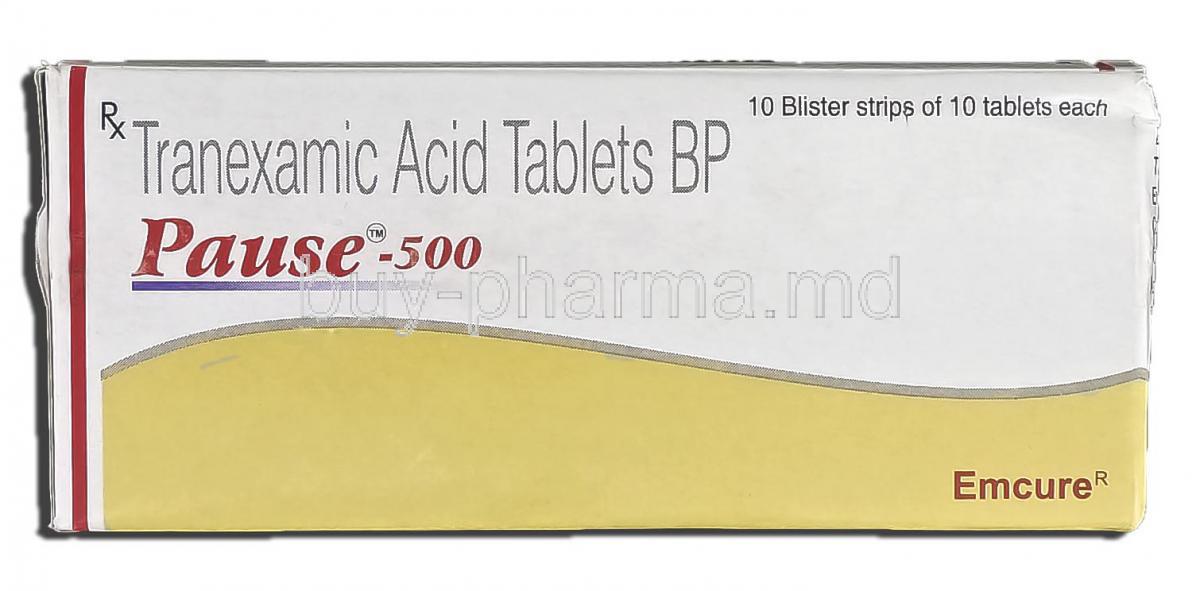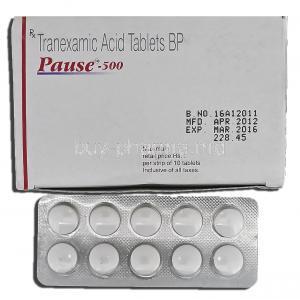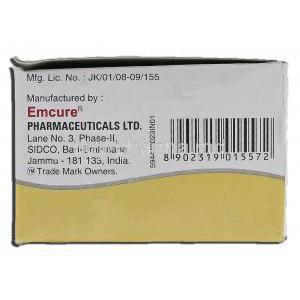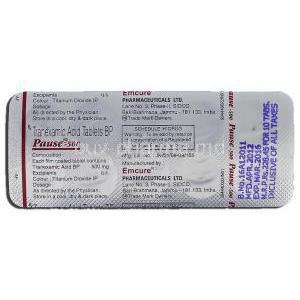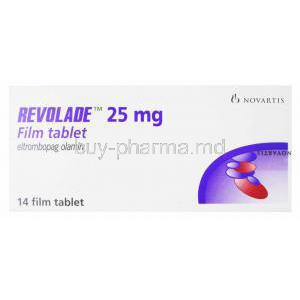Introduction
Overview of Pause (Tranexamic Acid)
Pause, containing the active compound tranexamic acid, is a potent antifibrinolytic agent widely used to reduce excessive bleeding. It is particularly beneficial in conditions where abnormal or heavy blood loss impairs quality of life. Its ability to stabilize clots has made it a vital therapeutic tool across multiple medical disciplines.
Historical Background and Development of Tranexamic Acid
Tranexamic acid was first synthesized in the early 1960s in Japan. Developed as a synthetic derivative of the amino acid lysine, it soon gained international recognition for its hemostatic potential. Over the decades, its inclusion in global guidelines has solidified its reputation as a frontline therapy for hemorrhagic disorders.
Therapeutic Class and Pharmacological Profile
This drug belongs to the class of antifibrinolytic agents. It works by interfering with the breakdown of fibrin clots, thereby promoting hemostasis. Pharmacologically, tranexamic acid demonstrates excellent bioavailability in oral and parenteral forms and is primarily excreted through the kidneys.
Importance in Managing Bleeding Disorders
The significance of Pause in clinical medicine cannot be overstated. It provides effective management in:
- Heavy menstrual bleeding (menorrhagia)
- Surgical blood loss prevention
- Postpartum hemorrhage management
- Trauma-related uncontrolled bleeding
Composition and Formulations
Active Ingredient: Tranexamic Acid
The core pharmacological component of Pause is tranexamic acid, a synthetic amino acid derivative designed to inhibit fibrinolysis.
Available Dosage Forms
Pause is available in multiple delivery systems to suit diverse clinical needs:
- Oral tablets
- Intravenous injections
- Mouthwash preparations
- Topical and dermatological formulations
Strengths and Packaging Variations
Tablets are generally available in 250 mg and 500 mg strengths. Injections are provided in ampoules, while topical and mouthwash forms are offered in specialized packaging for controlled use.
Inactive Ingredients and Excipients
Formulations may include stabilizers, fillers, and preservatives that aid in tablet integrity, shelf-life, and patient tolerability.
Mechanism of Action: How Tranexamic Acid Works
Antifibrinolytic Effect and Role in Clot Stabilization
Tranexamic acid exerts an antifibrinolytic action by preventing clot degradation. This effect strengthens existing fibrin matrices and maintains hemostatic balance.
Inhibition of Plasminogen Activation and Fibrin Breakdown
It blocks lysine-binding sites on plasminogen molecules, impeding their conversion into plasmin. As a result, fibrin clots remain intact for longer durations.
Duration of Action and Onset of Effect
The therapeutic onset begins within two to three hours after oral administration. Its duration of action ranges between 6–8 hours, depending on renal function and dosing frequency.
Comparison with Other Antifibrinolytics
Compared to older agents such as epsilon-aminocaproic acid, tranexamic acid exhibits stronger antifibrinolytic efficacy with better patient tolerability.
Medical Uses of Pause (Tranexamic Acid)
Control of Heavy Menstrual Bleeding
Pause is widely prescribed for menorrhagia. It helps reduce menstrual blood loss significantly, allowing improved daily functioning and better iron balance in women affected by chronic heavy periods.
Management of Postpartum Hemorrhage
In obstetric emergencies, tranexamic acid reduces maternal morbidity by decreasing blood loss. It has become a cornerstone therapy in postpartum hemorrhage protocols worldwide.
Surgical Applications
Tranexamic acid is utilized in multiple surgical specialties:
- Orthopedic operations such as hip and knee replacements
- Cardiac surgeries with high bleeding risk
- Dental extractions, particularly in hemophiliac patients
Trauma and Emergency Medicine
Clinical evidence from large-scale trials like CRASH-2 demonstrated its survival benefits in trauma patients with significant bleeding. It reduces transfusion requirements and improves overall outcomes when administered early.
Hemophilia and Inherited Bleeding Disorders
Pause serves as an adjunct therapy in hemophilia to control mucosal and dental bleeding episodes. It complements factor replacement therapy in affected individuals.
Off-Label Uses of Tranexamic Acid
Beyond its approved indications, tranexamic acid has gained attention in various conditions:
- Dermatology: Used in melasma and hyperpigmentation management
- Epistaxis: Effective in reducing recurrent nosebleeds
- Gastrointestinal bleeding: Adjunctive role in selected cases
- Hereditary angioedema: May reduce frequency and severity of attacks
- Cosmetic medicine: Employed for skin whitening and aesthetic pigmentation control
Dosage and Administration
Recommended Dosages for Different Indications
Typical dosing regimens vary based on the condition treated. For menorrhagia, 1 g orally three times daily during menstruation is standard. Trauma and surgical protocols often involve IV infusion.
Oral vs. Intravenous Administration Guidelines
Oral tablets are used in chronic or scheduled treatment, while IV formulations are preferred in acute, high-risk bleeding scenarios.
Duration of Treatment
Short-term therapy is recommended in acute cases, whereas long-term administration is reserved for recurrent conditions under strict monitoring.
Dose Adjustments in Renal Impairment
As the drug is eliminated renally, patients with impaired kidney function require dosage modification to avoid accumulation and toxicity.
Missed Dose Instructions
If a dose is missed, it should be taken as soon as remembered unless it is close to the next scheduled dose. Double dosing should be avoided.
Side Effects of Tranexamic Acid
Common Side Effects
Most patients tolerate Pause well, but mild side effects may occur, including:
- Gastrointestinal upset such as nausea or diarrhea
- Headache and dizziness
- Fatigue and muscle discomfort
Serious Adverse Effects
Though uncommon, serious events may develop:
- Deep vein thrombosis or pulmonary embolism
- Visual disturbances and retinal changes
- Severe hypersensitivity reactions
Drug Interactions
Drug interactions must be carefully considered:
- Hormonal contraceptives increase thrombotic risk when combined with tranexamic acid
- Concurrent use with anticoagulants or antiplatelet drugs requires caution
- Hemostatic agents may amplify clotting effects
- Possible interference with coagulation lab results
Contraindications
Pause should not be used in patients with:
- A history of thromboembolic disease
- Subarachnoid hemorrhage
- Known hypersensitivity to tranexamic acid
- Active intravascular clotting disorders
Warnings and Precautions
Clinical vigilance is essential when prescribing Pause:
- Heightened thrombosis risk in predisposed patients
- Renal impairment necessitates careful monitoring
- Visual changes should be promptly investigated
- Long-term therapy requires periodic reassessment
Special Populations
Administration to Elderly
In elderly patients, physiological changes may alter how tranexamic acid is processed in the body. Reduced renal clearance and slower metabolism often result in prolonged drug exposure. These changes necessitate vigilant monitoring and individualized dosing strategies.
Particular caution should be exercised due to increased susceptibility to cardiovascular and renal complications. Routine evaluation of kidney function and cardiovascular status is highly recommended. Adjustments in dosage may be required to maintain therapeutic safety while avoiding toxic accumulation.
Administration to Pregnant Women
The use of tranexamic acid during pregnancy, especially in the peripartum period, has been investigated extensively. It is generally considered safe when administered under strict medical supervision. The benefits in preventing or controlling postpartum hemorrhage often outweigh potential risks, particularly in life-threatening situations.
Clinical guidelines emphasize a careful risk–benefit assessment. Decisions regarding its use should account for maternal health status, obstetric conditions, and the availability of alternative interventions.
Use in Nursing Mothers
Tranexamic acid is known to be excreted in small amounts through breast milk. While the concentrations are typically low, clinical prudence is required. Infants should be monitored for signs of gastrointestinal upset or unusual behavior.
Breastfeeding is not universally contraindicated, but recommendations often suggest limiting use to situations where therapeutic benefits for the mother clearly surpass potential risks for the infant.
Administration to Children
In pediatric populations, dosing must be carefully calculated based on body weight and the specific condition being treated. Tranexamic acid has demonstrated efficacy in controlling bleeding in children, particularly those with hereditary disorders such as hemophilia.
Close monitoring is essential, as children may exhibit different pharmacokinetic responses compared to adults. Regular evaluation of renal function and overall tolerance enhances the safety profile in young patients.
Overdosage and Emergency Management
Symptoms of Overdose
Excessive intake of tranexamic acid may provoke a range of symptoms, including:
- Seizures and neurological disturbances
- Severe hypotension and circulatory instability
- Nausea, vomiting, and gastrointestinal distress
Supportive Care and Gastric Decontamination
In suspected overdose, immediate medical evaluation is critical. Supportive care remains the cornerstone of treatment. Gastric lavage and activated charcoal may be considered if ingestion is recent.
Monitoring and Management of Complications
Continuous monitoring of vital signs, renal function, and neurological status is required. Symptomatic therapy, including anticonvulsants for seizures and intravenous fluids for blood pressure stabilization, should be employed as necessary.
Storage and Handling Precautions
Recommended Storage Conditions
Tranexamic acid should be stored in a cool, dry environment, away from direct sunlight and excessive moisture. Optimal temperature control helps maintain potency and prevents degradation.
Safe Handling and Disposal
Unused or expired medicine should be disposed of responsibly, ideally through pharmaceutical take-back programs. Patients are advised not to discard medication in household waste or wastewater to avoid environmental contamination.
Stability and Shelf-Life
Tablets and injections generally retain stability throughout their labeled shelf-life if stored under recommended conditions. Regular inspection of packaging for signs of damage or discoloration is advised before use.
Important Precautions for Patients
Recognizing Early Signs of Adverse Reactions
Patients should remain vigilant for early warning signs such as unexplained leg pain, shortness of breath, chest discomfort, or sudden visual disturbances. Prompt recognition allows timely medical intervention.
Guidance on Lifestyle Modifications
Certain lifestyle changes can mitigate clotting risks during treatment. Recommendations include:
- Maintaining hydration and regular physical activity
- Avoiding prolonged immobility, particularly during travel
- Adhering strictly to prescribed dosage without self-adjustment
When to Seek Immediate Medical Attention
Urgent medical consultation is required if patients experience severe headache, sudden weakness, loss of vision, chest pain, or signs of thrombosis. Rapid response to these symptoms reduces the likelihood of life-threatening complications.
Pause, Tranexamic acid FAQ
- What is tranexamic acid pause used for?
- Can I just stop taking tranexamic acid?
- Can pause 500 stop miscarriage bleeding?
- How many days to take tranexamic acid to stop bleeding?
- How much time does pause-mf take to work?
- What are the side effects of tranexamic acid?
- What happens to period blood when you take tranexamic acid?
- When to stop using tranexamic acid?
- Does tranexamic acid make you gain weight?
- Is pause 500 a blood thinner?
- How long does it take for tranexamic acid to work?
- Will I start bleeding again when I stop taking tranexamic acid?
- How long does tranexamic acid stay in your body?
- Can I take pause 500 twice a day?
- How many pauses MF to take in a day?
- Can tranexamic acid damage kidneys?
- Can tranexamic acid make you sleepy?
- What is a natural alternative to tranexamic acid?
- Does tranexamic acid lighten your period?
- Does tranexamic acid affect fertility?
- Can tranexamic acid cause anxiety?
- Can tranexamic acid cause stroke?
- How long does it take for tranexamic acid to stop your period?
- What happens if you take tranexamic acid while pregnant?
- When not to use tranexamic acid?
- How long should I wait between tranexamic acids?
- Can tranexamic acid stop bleeding after a miscarriage?
- How long does it take for pause 500 to stop bleeding?
- Is it safe to take tranexamic acid every day?
- What happens to period blood when you take tranexamic acid?
What is tranexamic acid pause used for?
Pauses 500 tablets are used to stop excessive bleeding.
Can I just stop taking tranexamic acid?
Yes
Can pause 500 stop miscarriage bleeding?
Yes
How many days to take tranexamic acid to stop bleeding?
7 days
How much time does pause-mf take to work?
1-2 hours
What are the side effects of tranexamic acid?
- Pale skin
- Breathing difficulties
- Unusual bleeding
- Fatigue
What happens to period blood when you take tranexamic acid?
Tranexamic acid plays a role in blood clotting, which in turn helps cut down on bleeding.
When to stop using tranexamic acid?
If you notice any blood clots or eye problems
Does tranexamic acid make you gain weight?
Yes
Is pause 500 a blood thinner?
No
How long does it take for tranexamic acid to work?
24 hours
Will I start bleeding again when I stop taking tranexamic acid?
Yes
How long does tranexamic acid stay in your body?
2 days
Can I take pause 500 twice a day?
No
How many pauses MF to take in a day?
Once daily
Can tranexamic acid damage kidneys?
Tranexamic acid can be damaging to the kidneys. One way it can cause harm is by increasing the likelihood of blood clots forming, which can clog the vessels in the kidneys and lead to complications, including necrosis.
Can tranexamic acid make you sleepy?
Yes
What is a natural alternative to tranexamic acid?
Ginger capsules and myrtle fruit syrup
Does tranexamic acid lighten your period?
Yes
Does tranexamic acid affect fertility?
No
Can tranexamic acid cause anxiety?
Yes
Can tranexamic acid cause stroke?
Rarely
How long does it take for tranexamic acid to stop your period?
24 hours
What happens if you take tranexamic acid while pregnant?
Tranexamic acid is usually thought to be safe for women and can help control bleeding after childbirth when heavy bleeding can be a problem.
When not to use tranexamic acid?
- Coagulopathy
- Epilepsy
- Kidney problems
- Pregnant or trying to get pregnant
How long should I wait between tranexamic acids?
6 hours apart
Can tranexamic acid stop bleeding after a miscarriage?
Yes
How long does it take for pause 500 to stop bleeding?
5 days
Is it safe to take tranexamic acid every day?
No
What happens to period blood when you take tranexamic acid?
Blood clots which reduce bleeding

